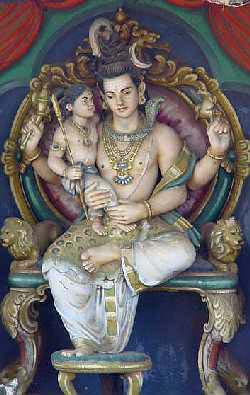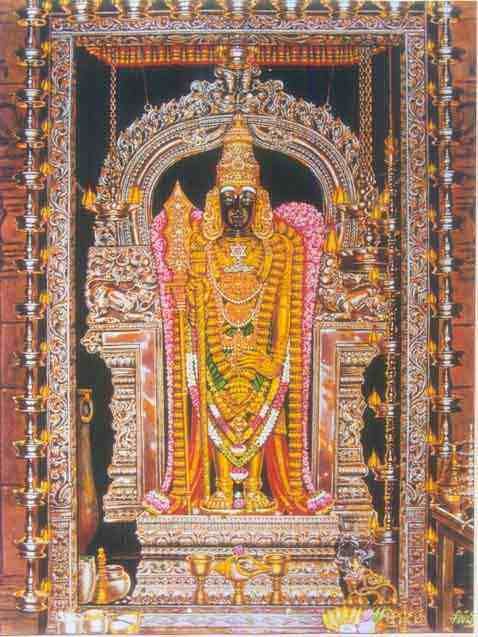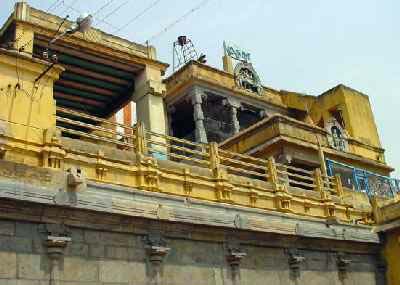Swamimalai - is located on the banks of river cauvery – at a distance of 5 KM along the western side of Kumbakonam in Tamil nadu, India. The temple is located at a height of 60 feet – above an artificial hillock and is reached by a flight of 60 steps – which signify 60 years. This south Indian temple of Swaminatha Swami can be reached easily by motorable roads from Kumbakonam.
There are three prakarams and three entrances in this Murugan shrine. The southen entrance is the main entrance to the temple and the main temple tower (Raja gopuram) – with its 5 tiers – is located above this entrance.There is a temple dedicated to Meenakshi Sundareswarar ( depicting Lord Vishnu giving his sisters hand in marriage to Lord Shiva ) – this temple is known as Kizh Koil . The main temple that enshrines Lord Muruga as Swaminadha swami is known as Mel Koil. There are several small temples around the Meenakshi Sundareswarar temple. As we enter the 2nd Prakaram, there is a very beautiful structure that portrays the teaching of Omkara by Muruga to Lord shiva. Once we cross the 2nd prakaram we can see the temple of Netra Vinayagar (Lord Ganesh who blessed a devotee with eyesight) -
along with s tatues of several other gods and goddesses including Karthaveeryarjuna, Idumban and subramanya swamy. As we approach the sanctum sanctorum, we pass across worshipping Sabhabathi, Senapathi, Shanmuka with Valli and Devasena – all being various manifestations of Lord Kumara or Karthikeya.
There is a beautiful statue of Nataraja or dancing Lord Shiva as well. Poet Saint Arunagirinathar – who sings about this temple in detail in this sacred Tamil hymn Thiruppugazh is also represented in the form of an idol here. The main lord of swami malai – affectionately called as Swaminadha – is 6 feet tall with broad shoulders holding sakthi vel and dhandam(staff). Instead of Mayil Vahanam or the peacock vehicle, Elephant is depicted as the vahana (divine vehicle) in front of the lord. This feature is very unique, not available in any other temples of Lord Muruga. The stala vriksham for Thiruchendur temple is the Amla tree( Nellimaram) .

There are five Theerthams or divine water sources, in and around the temple. They are: Vajra Theertham, Saravana Theertham Netra Pushkarini( well)and Kumaratturai (Kaveri) Legend has it that a blind devotee by name Sumathi lost his eyesight because of his sins. Sage Bharatwaja asked him to go and worship Netra vinayaga and take a dip in the Netra teertham to get over his sins and regain his sight. It is believed that the devotee took a dip in the
sacred waters and regained his sight as he approached the Netera Vinayagar temple.

Legends – Puranas and Mythology Nakeerar, in his Tamil
writings compilation called Thirumurugatruppadai, more than 2000 years ago, and
saint Poet Arunagirinaathar, who has composed 95 verses on Murugan, have both sung in great praise of Lord of Swamimalai.Literary references to the place are also available in many other ancient tamil scriptures and inscriptions. It is believed that Lord Muruga teached the significfance of Pranava Mantra (the sacred OM) to Lord Shiva – his father – here and hence the name Swami malai for the place and Thagappan swami for the Lord. This temple is of great spiritual importance to the devotees of Lord Skanda – also known as Kanda and Arumuga – as
he became a guru to his own father who is considered as the Lord of the universe. It is worshipped by thousands of devotees throughout the year. Location and Temple Precincts - The battle of Lord Muruga with Soorapadman is enacted to the fervor of the Muruga Bakthas in the Tamil month of Masi at Tiruchendur ending with the marriage of Lord Murugan with Deivayanai (Devanai).
The History
Swamimalai is one of the very ancient temples of Tamil Nadu. One can see that it is mentioned in Thirumurukaatrup-padai of Nakeerar, compiled under ‘paththuppaattu’ (Ten verses) of Sangam period, which belongs to second century B.C. The shrine therefore is evidently older than 2400 years. It is believed to have been constructed by Parantaka Chola I. But recent history and documentation show that the temple was damaged to a great extent and the gopurams were demolished during the Anglo-French war of 1740 A.D.
The temple of Swaminatha is built on the hillock. At the foot of the hillock, there is a temple for Lord Shiva, who played the ‘Taught’. His temple is situated at a lower plane to indicate the superiority of the ‘Master.’ Lord Shiva is known as Sundaresa and His Consort, Meenakshi.
There are three beautiful gopurams on all three sides - east, west and north. On the south is situated the massive and main gopuram, known as the Rajagopuram. There are three prakarams in the temple. There is a shrine for Vinayaka, who is known by the name Netra Vinayaka. It is said that a blind man had his vision restored, after he worshipped Vinayaka here and from then on, Ganesa is known as Netra Vinayaka in Swamimalai.

There are other shrines in the prakaram for Agastya, Visalakshi, Lakshmi, Saraswathi and other deities. There is a shrine for Lord Muruga in a corner, where He resides with His consort, Devayani. This is the only shrine where Subrahmanya is seen with Devayani alone, without the other Consort, Valli. Moreover, the usual divine vehicle, peacock is absent in this shrine. Instead, there is a white elephant is found in front of the Lord. It is said that Indra, in gratitude for having saved him from Asuras, presented the Lord with his own vehicle, Airavatam, the white elephant and hence the peacock is absent in Swamimalai.
Krittika is an important day for a visit to the shrine. The main festivals are Brahma Utsavam, Skanda Shasti and the festival of His marriage with Valli. Vibuthi Abhishekam - smearing of the deity with holy ashes - is a special feature in Swamimalai, as it is in Palani.
The temple is very important from the literary, historic and also devotional points of view.
Pujas and Festivals
Daily pujas to the deities are performed six times a day (six kalams). Usha Kalam, Kalasandhi and Uchikala poojas are performed in the forenoon and the afternoon poojas commencing from Sayaratchai and Rendam kalam are concluded with Arthajama pooja in the night.
The important festivals conducted in the temple are:
- Monthly Kirutikai festival;
- Temple Car festival in April;
- Visakam festival in May;
- Navaratri festival in May;
- Skanda Shashti festival in October;
- Tiru Karthikai festival in Nov/December;
- Taippūcam festival in January; and
- Pankuni Uttiram festival in March